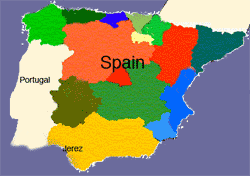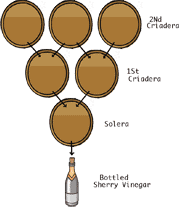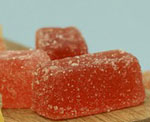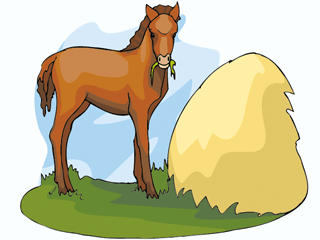Sherry Vinegar
"Sherry vinegar is very reasonably priced
even though it is so well known in the world of haut cusine!"
Sherry vinegar, along with the sherry wine from which it is produced, is made with the Palomino grape grown in the Andalusia region of Spain.
 A special micro-climate exists in the south western part of Andalusia where the three principal sherry towns can be found:
A special micro-climate exists in the south western part of Andalusia where the three principal sherry towns can be found: - 1) Jerez de la Frontera
- 2) Sanlucar de la Barrameda
- 3) Puerto de Santa Maria
From these three towns virtually all the genuine sherry and its related vinegar is produced and shipped worldwide.
The Jerez DOC (denomination of origin) label was created in 1994 to ensure that this aged liquid, called "Vinagre de Jerez", always meets strict quality standards.
Sherry vinegar has a complex balanced sweet and sour taste with hints of oak and nuts in a sherry wine base. It is well known in the world of "haute cusine" and its popularity for home use is steadily increasing each year.
It is sold in two age categories, the first is aged for at least six months in oak barrels while the second category, called Reserva, has to be aged in oak casks for at least two years. Many fine Reserva vinegars are available on the market that have been aged for 12, 25, 40 and even 80 years.
Naturally the older the vinegar the more exquisite its taste and the higher its value. Nevertheless, when compared to similarly aged traditional balsamic vinegar from Italy, this Spanish vinegar is much more affordable. Couple that with the fact that the Reserva product has a complexity of taste like that of balsamic vinegar and it is not hard to understand why sherry vinegar can be used, when needed, as a substitute for balsamic vinegar. Conversely, aged balsamic vinegar can be used as a sherry vinegar substitute."
The Solera aging process
The traditional system of aging sherry wine and vinegar is called the Solera process.
This system makes use of many 500-litre oak barrels, stacked 3 or more levels high, which previously contained sherry wine but now contain sherry vinegar of different ages.

The oldest vinegar is stored in the bottom row of barrels called the Solera and this is the final stage vinegar used for bottling and sale.
No more than a third of the liquid in the Solera is removed for bottling at one time.
This third is then replaced with younger vinegar from the first row of barrels stored directly above the Solera called the first Criadera.
The volume in the first Criadera is then replenished with younger vinegar from the row of barrels stored above the first Criadera aptly called the second Criadera.
Finally the top row of barrels is filled with the newest and youngest sherry vinegar.
This time honored aging and blending process insures that consistent quality vinegar is always produced from year to year.
All the oak barrels are placed in vast, well-ventilated structures called bodegas where they are exposed to lots of fresh air and warmth.
Since these wooden barrels are never completely filled or sealed, they constantly receive air needed for the vinegar maturation process and that also helps to assure consistent quality.
Aged sherry vinegar manufacturers and their product labels
Some of these fine aged products sold throughout North America in health food stores or on the internet include:
1) Cala & Arrobas- Duque de Diano Jerez Sherry wine Vinegar - aged approximately 25 years
- Duque de Diano Reserve - aged in the solera for about 50 years
- Cepa Vieja - 7% acidity, aged.
- Gran Reserva - 9% acidity, aged in a solera dating back 85 years
3) Jose Paez Lobato
- Capirete Solera 8 - 8% acidity, 8 year aging
- Capirete 20 Reserve - 8% acidity, 20 year aging
- Gran Capirete Reserve - 8% acidity, 50 year aging
Recipes using this "Spanish gold"
Sherry vinegars are used extensively in cooking for marinades and salad dressings, for tomato based soups and sauces and even as a fruit topping. Here are three examples:
1) Gazpacho (classic cold Spanish soup) - makes 3 servings
- .......Ingredients........
- 500g (16 oz) ripe tomatoes, peeled and chopped
- 1 cucumber, peeled and seeded then diced
- 1/2 sweet bell pepper, seeded and chopped
- 1 clove garlic, peeled and chopped fine
- 1 thick slice sourdough bread, remove crust
- 150 ml (5 oz) water
- black pepper, freshly ground to taste
- 3 tbsp aged sherry vinegar
- 3 tbsp extra virgin olive oil
Soak bread in a large bowl with 150 ml (5 oz) water for 5 minutes and then break into pieces.
Add chopped tomatoes, diced cucumbers and pepper and finely chopped garlic.
Add olive oil and vinegar and a pinch of black pepper then let stand for an hour.
Pass the mixture through the blender until you obtain a soup of the desired consistency.
For a stronger flavor add more vinegar.
2) Sherry Vinaigrette Salad Dressing
- .......Ingredients.......
- 1 cup olive oil
- 1/3 cup sherry vinegar
- 1 teaspoon dijon mustard
- 1/2 teaspoon Salt
- Black pepper to taste
In this video, chef John shows you an excellent way to prepare this favorite all purpose salad dressing, explaining how best to emulsify it.
3) Strawberries with Sherry Vinegar - makes 3 servings
- .......Ingredients........
- 225g (1/2 pound) strawberries
- Sugar to taste
- Sherry vinegar to taste
Wash and drain the strawberries and place them in a dish.
Add sugar on top of the strawberries to taste then add a dash of vinegar.
Let stand for 2 hours to allow the sugar, vinegar and strawberry juice to blend and form a delicious syrup.






